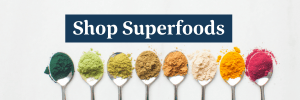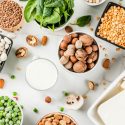What is a Superfood?
Superfoods are nutrient-dense foods that are especially beneficial to your health. The comprehensive superfood guide below illustrates the benefits of common superfoods and simple ways to use them.
Disclaimer: At Spud we believe that a superfood is any food that makes you feel super! Sometimes this is spinach or spirulina, and sometimes it can be chocolate or mac and cheese. Although it is great to fuel up on the amazing superfoods below, it is also important to listen to your body. Some foods aren’t as rich in nutrients, but are just as rich in flavor, comfort, nostalgia, or fun!
Turmeric
Turmeric is an incredibly potent anti-inflammatory and antioxidant. Curcumin, the active ingredient in turmeric, is what gives it these medicinal properties. Curcumin helps with a number of health concerns such as arthritis, eczema, IBS, and other autoimmune diseases because it helps reduce inflammation in the body. It also aids digestion because it reduces bloating and gas. As well, many studies have shown that curcumin has anticancer effects, particularly that it can kill cancer cells and prevent more from growing. One 2007 study on mice showed that curcumin helped stop the spread of breast cancer cells to other parts of the body. It makes sense that turmeric is considered one of the world’s healthiest foods!
*It’s important to note that the body cannot absorb curcumin well on its own. As a solution, make sure you consume it with pepper. Piperine, the active ingredient in pepper, enhances curcumin’s bioavailability by 2000%!
How to Use: Add to curries, soups, vegan tofu scramble
Maca
Maca is rich in fiber, vitamin c, Fatty acids, and other nutrients. It is an adaptogen that supports the adrenal system and can balance hormones.
How to Use: Macca has a caramel-like flavour, add 1/2 tsp to hot chocolate, smoothies or desserts.
Chia
While chia seeds are slightly lower in protein and omega-3 acids, they are still a fantastic source of these vital nutrients. In terms of calcium, fibre, and phosphorus, however, chia seeds are superior. In fact, they’re more than double the calcium found in flaxseeds. Higher fibre content also means that you’ll feel full longer after a meal, your blood sugar level will be regulated, your cholesterol level will be healthier, and your bowel movements will be easy and breezy.
What about micronutrients? Although they don’t pack as much magnesium, potassium, vitamin B1, folate, and copper as flaxseeds, they are still great sources nonetheless. They do exceed flaxseeds in selenium content, however, a powerful antioxidant that helps lower risks of heart disease and cancer. And along with the lignan content also found in chia seeds, these seeds are undoubtedly a valuable ingredient to fight cancer.
How to Use: Make chia pudding, add to smoothies, make a chia egg, make chia jam
Flax
Flaxseeds are also higher in magnesium and potassium, which are both essential for muscle function. With a good content of copper, zinc, iron, manganese, and phosphorus—all of which are higher than chia seeds—flax seeds are one of the best sources of essential minerals.
But that’s not even really where flaxseeds shine most. Flax seeds are the number one source of lignan, which may help combat certain forms of breast cancer, osteoporosis, and cardiovascular diseases, as well as alleviate hormonal symptoms of menopause.
How to Use: Add to smoothies, and oatmeal, make a flax egg, flax crackers
Bee Pollen
When you take a look at the nutritional makeup of bee pollen, you can see why it’s been called one of the world’s most nourishing foods. One tablespoon of bee pollen has approximately 45 calories, and a 35% protein makeup. It’s one of the richest sources of vitamins in a single food, with eighteen vitamins including a B complex, all essential amino acids, fatty acids, and enzymes. All of that was created by a little bee, and a few flowers.
A few cautions:
If you have allergies, talk to your doctor before taking bee pollen. In some cases, bee pollen has caused an allergic reactions, including anaphylaxis.
Bee pollen is also not advised for pregnant, breastfeeding women, or anyone taking blood-thinning medication.
How to use: add to a smoothie, oatmeal, granola, or yogurt bowls
Moringa
Moringa contains 92 nutrients, 46 antioxidants, and all of the essential amino acids. It has seven times the vitamin C of oranges, three times the potassium of bananas, four times the calcium in milk, and four times the vitamin A in carrots.
How to Use: add to matcha lattes, smoothies and more!
Collagen
Collagen is one of the main proteins in the body and makes up most of our body’s tissues, muscles, bones, skin, hair, digestive system, and tendons–to name a few. As we age, our collagen production naturally decreases. Extreme sun exposure and improper diets speed this up. We can supplement natural collagen with collagen powder to improve the health of skin, hair, and nails.
How to use: Add to smoothies or blend into coffee
Spirulina & Chorella
Spirulina and Chlorella are both blue-green algae that are high in protein and vitamins. Both superfoods contain 2-3 grams of protein per teaspoon and are rich in antioxidants which can help reduce inflammation and may help fight chronic diseases.
How to use: Add to smoothies, salad dressings, or energy bars


















